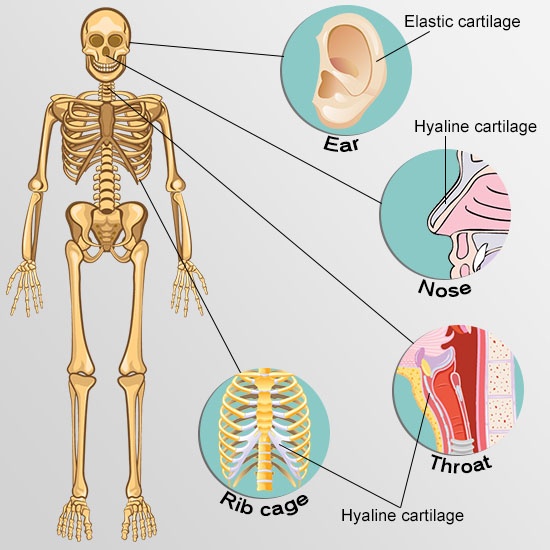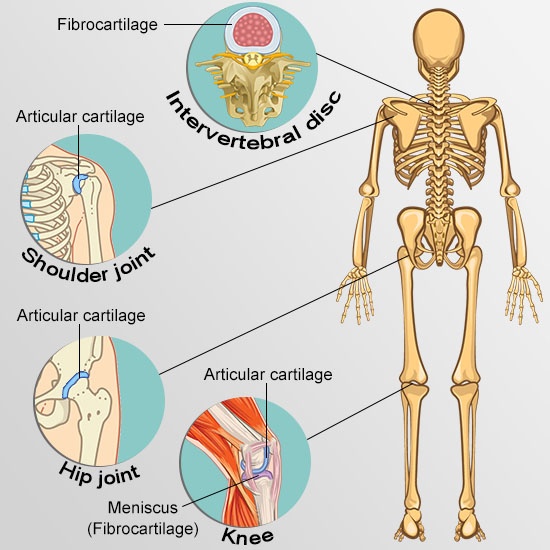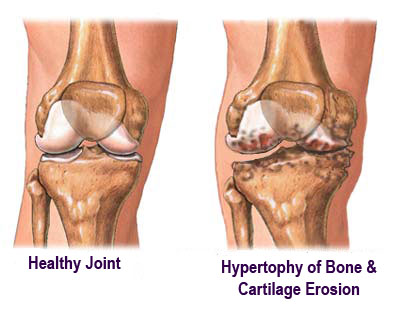Cartilages are tough, flexible tissues found in many parts of the body. They serve two main functions: to act as shock absorbers and as molds that provide structure.
Some cartilages cover joint surfaces and enable bones to slide against one another with minimal friction, thus preventing damage. They also support your weight and protect your bones as you bend, stretch, or run. Other tough, flexible tissues are also ideal for serving as specially shaped molds for curved body parts and to support the bones.
Types of Cartilage
The three main types of cartilage are:
- The elastic cartilage, which makes up the outer ears, part of the nose, and your epiglottis (a flap of tissue in the throat that prevents food from entering your airways)
- The fibrocartilage, which is found between the vertebrae in the spine and between bones of the pelvis and hips
- The articular cartilage, which is a tough and springy type of cartilage in between ribs, around your trachea (windpipe) and between joints


These cartilages can be damaged in different ways. For example, the external ear cartilage can be damaged by a blow to the ear, which can make it look deformed ("cauliflower ear"). The cartilages between the vertebral discs in your spine can also be damaged, resulting in slipped disc, which is a common age-related problem. Cartilages found in joints like the knee are often damaged from accidents, injuries, or normal wear-and-tear.
Damage to the articular cartilage can be managed through cartilage regeneration, which is the main focus of this article.
Causes of Articular Cartilage Damage
Damage to the articular cartilage is a very common and potentially serious type of injury, which usually affects the knee joints. Cartilage damage can result in severe pain, inflammation and loss of mobility.
Articular cartilage damage can occur in different ways:
- Infection
- Accidental injury through sports or falls
- Osteoarthritis, which involves chronic damage and inflammation of the joints. This type of damage usually affects obese individuals, people with problems in their joint structure, and those whose knee meniscus has been removed.
- Osteochondritis dissecans, a condition wherein a small portion of your cartilage and attached piece of bone comes away from the joint.

Does Cartilage Regrow by Itself?
No, it doesn't. Unfortunately, unlike other tissues, cartilage does not regrow by itself because it does not have blood vessels to supply blood circulation. Blood cells are important to help repair damaged tissues, so if a cartilage is damaged, it cannot heal quickly like damaged skin. In other words, natural cartilage regeneration does not occur.It is, therefore, really critical to make sure that the amount of cartilage loss after an injury is minimized to overcome the challenges when dealing with strategies to repair cartilages.
Current Approaches for Cartilage Regeneration
Research has been done to restore damaged joint cartilages through cartilage regeneration.So far, techniques for this procedure are still in the experimental stage in theUnited States, although it is now being done in Europe. Current approaches include:
Microfracture Surgery
Surgeons now use microfracture surgery, a technique to promote growth of new cartilage. This type of surgery is usually done in young adults who sustain a tear in the knee joint cartilage after a sports injury. It is not effective in elderly patients with osteoarthritis or generalized cartilage degeneration.
How it's done: Microfracture surgery involves drilling of tiny holes into the bone below a damaged cartilage. This releases blood cells and stem cells into the space where the damaged cartilage is found. This results in a super clot that provides a rich environment of cells that promote cartilage regeneration.
Effects and side effects: Only half of microfracture surgeries are successful after a long period. The main issue with this technique is that the super clot produces fibrocartilage, which is a mixture of hyaline cartilage and scar-like tissue. Unlike the original hyaline cartilage which was damaged, fibrocartilage is tough, dense and unable to function well as a cushion between joints. In addition, microfractures can also stimulate bone production, which can infiltrate the regenerating cartilage and disrupt its function.
Other Cartilage Regeneration Techniques
- Debridement/abrasion is a technique wherein the surgeon removes loose cartilage through arthroscopy. This causes bleeding at the surface of the bone and promotes growth of fibrocartilage. However, this fibrous cartilage/ scar tissue may not be very strong.
- Mosaicplasty (osteochondral autograft transplantation) is a technique wherein the surgeon removes a plug of bone and cartilage covering from a healthy portion of the joint to transplant it to a damaged area of the joint.
- Periosteal flap is a technique wherein the surgeon removes part of the connective tissue covering the bones (periosteum) of the shin to transplant it to the damaged cartilage.
- Autologous chondrocyte implantation is a technique wherein the surgeon removes a small portion of knee through arthroscopy, and sends the tissue to a laboratory to be cultured. A second surgery is done to implant the lab-grown tissues at the damaged site of the cartilage.
- Osteochondral allografts - This is a technique wherein a donor's bone is used to repair damaged cartilage.
All of these cartilage regeneration procedures have mixed results. Many questions still plague attempts to regenerate cartilage. More research is needed to develop procedures that can relieve arthritis and produce durable replacements for damaged cartilages.
Vitamins for Cartilage Regeneration
According to the University of Washington Orthopedics and Sports Medicine, vitamins included as part of your diet can promote your body to mend itself. However, it is always a good idea to consult your doctor first before starting any supplements. The vitamins that may be helpful include:
- Vitamin A to fight free radicals and enhance healthy tissue throughout the body, which is rich in foods such as organ meats such as liver and kidneys, cod fish oil, and dairy products (cheese, cream, milk, and eggs).
- Vitamin C to form collage which helps to make tendons, blood vessels and ligaments, which can be found in foods such as citrus fruits and juices, watermelon, cantaloupe, mango, papaya, pineapple and berries.
- Vitamin D to promote bone health, which can be obtained from foods such as fish, oysters, fortified foods (cereals and milk) and dairy foods (cheese, butter and cream).
- Vitamin K to support the growing of new bone tissue, which is abundant in foods such as chard, parsley, watercress, kale, olive and canola oils.
